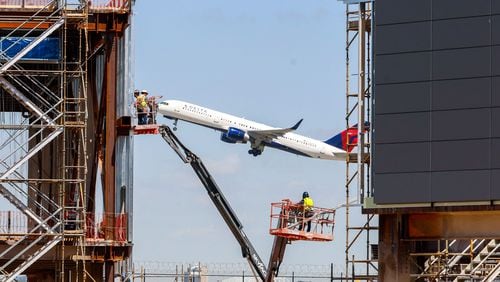The first prefab section of a Concourse D expansion at Hartsfield-Jackson International was successfully transported overnight to the site where it’ll be installed, the airport said Wednesday.
It’s the culmination of a process of building the prefab section at a construction site near the airfield, so the concourse can be expanded without shutting down.
Concourse D is the narrowest concourse of the world’s busiest airport, and becomes overcrowded and congested during busy periods. Airport officials have been working for years on the plan to widen and extend the concourse.
Contractors spent months preparing to move the first huge piece of a concourse in the overnight hours, when flight operations slow to a trickle and the taxiways and runways on the south side of the airfield can be shut down to make way for the operation.
To move the huge building section, it sits atop a self-propelled modular transporter (SPMT) — a motorized platform on wheels. The vehicle moves at about 1 mph and is typically used to transport large things like oil refinery equipment, bridge sections, roofs and other sections of buildings.
It slowly traversed the route to the concourse from the construction site off Sullivan Road on the south side of the airfield, roughly a mile away. Normal operations on the airfield resumed by the early morning hours.
More pieces for the first phase of the expansion will be transported to the concourse site over a period of about five weeks. Each piece will be about 40 feet tall, 30 feet wide and up to 192 feet long.
Then, the sections will be attached to the working concourse like building blocks. That will be followed by interior work before the expansion opens. Six larger gates will reopen as construction shifts to another phase and another section of the concourse.
It will cost $1.4 billion and take until 2029 to complete all phases of the concourse expansion. Another $100 million is being spent on adding three gates to Concourse E to make up for D gates lost due to the work. The project received $40 million in federal funding from the federal bipartisan infrastructure law.
When it’s completed, Concourse D will go from 60 feet wide to 99 feet wide, but the number of gates on the concourse will decrease from 40 to 34. Though there will be fewer gates, they are designed to handle larger aircraft.
The concourse continues to handle flights and passengers while the prefab pieces are constructed, but there has been disruption visible to travelers.
To prepare to attach the expansion pieces, the airport closed eight gates on the north section of Concourse D for the first phase. Boarding bridges have been removed from the building and work has begun to remove the exterior surface of the building.







